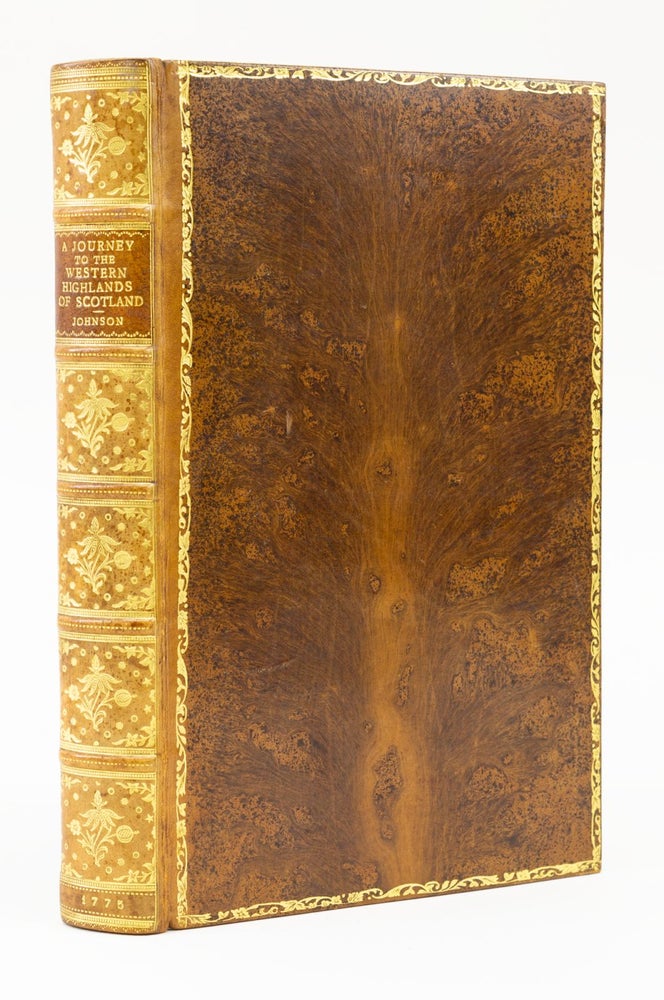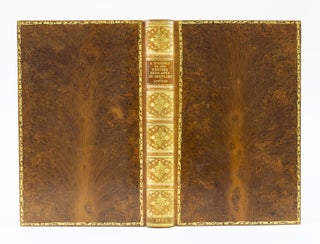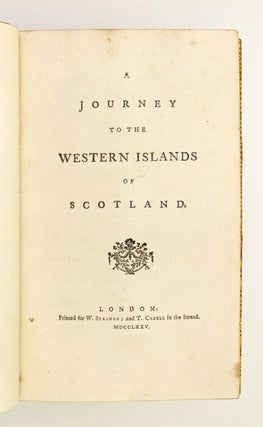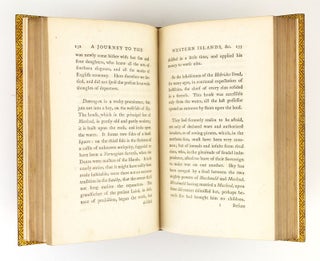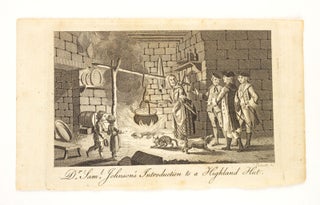A JOURNEY TO THE WESTERN ISLANDS OF SCOTLAND.
(London: Printed for W. Strahan and T. Cadell, 1775). 215 x 133 mm. (8 1/2 x 5 1/4"). 1 p.l., 384 pp., 1 leaf (errata, with 11 items on 12 lines), with cancels D8 and *U4, the latter in first state with incorrect page number. FIRST EDITION, First State.
Pleasing calf by Riviere & Son (stamp-signed on verso of front free endpaper), covers onlaid with tree calf panels bordered by gilt floral roll, raised bands, spine gilt in compartments with central spray of flowers and pomegranate within a lozenge of small tools, leafy sprig at corners, brown morocco label, gilt-rolled turn-ins, marbled endpapers, all edges gilt. Corrections for errors on p. 296 and 292 added to errata in pencil. Accompanied by an engraving of "Dr. Sam'l Johnson's Introduction to a Highland Hut" taken from "The Gentleman's Magazine," XLV, pp. 129-30 (1775), in which it was printed with an excerpt from this work. Courtney & Smith, p. 122; Fleeman 75.1J/1a; Rothschild 1256; Tinker 1357. ◆Leaves a little yellowed (due to paper quality), occasional patches of minor foxing, but an excellent copy, clean and fresh internally, in an unworn binding.
In a handsome period-style binding from Riviere & Son, this is Johnson's own account of the journey he took with Boswell in 1773 to the Scottish Highlands and the Hebrides. While briefer and perhaps less lively than Boswell's "Journal of a Tour to the Hebrides with Samuel Johnson" (1785), it is nevertheless a compelling series of observations upon what Johnson understood to be a different and more primitive civilization. Johnson speaks at length about the culture's "savage virtues," but most of his commentary consists of harsh criticisms of a society lacking the reasoned balance of his own. This attitude is captured in the laid-in illustration that shows Dr. Johnson, Boswell, and their interpreter (who translated the Scottish Gaelic, or Erse, spoken by most locals) inside a "Highland Hut" described in the text, with its friendly inhabitants: "an old woman boiling goat-flesh in a kettle" and two of her five children. Johnson relates that the woman "is a mistress of sixty goats . . . also some poultry . . . and a potato garden"--a relatively prosperous situation for a Highlander in the aftermath of the failed Jacobite rebellion. Though the smoky, windowless room, with dirt floors and few furnishings, is a long way from the comforts Johnson enjoyed in his London home, he was touched by his reception: "With true pastoral hospitality, she asked us to sit down and drink whiskey." The most eloquent passages in the book, almost approaching Milton in their sublimity, are prompted by the wild landscape, which reminds Johnson both of the precarious fate of humankind and of man's paradox of greatness and weakness. Our copy has cancels D8 and *U4, as usual, with the first state (erroneous page number on verso) of U4. (ST17032)
Price: $2,400.00

